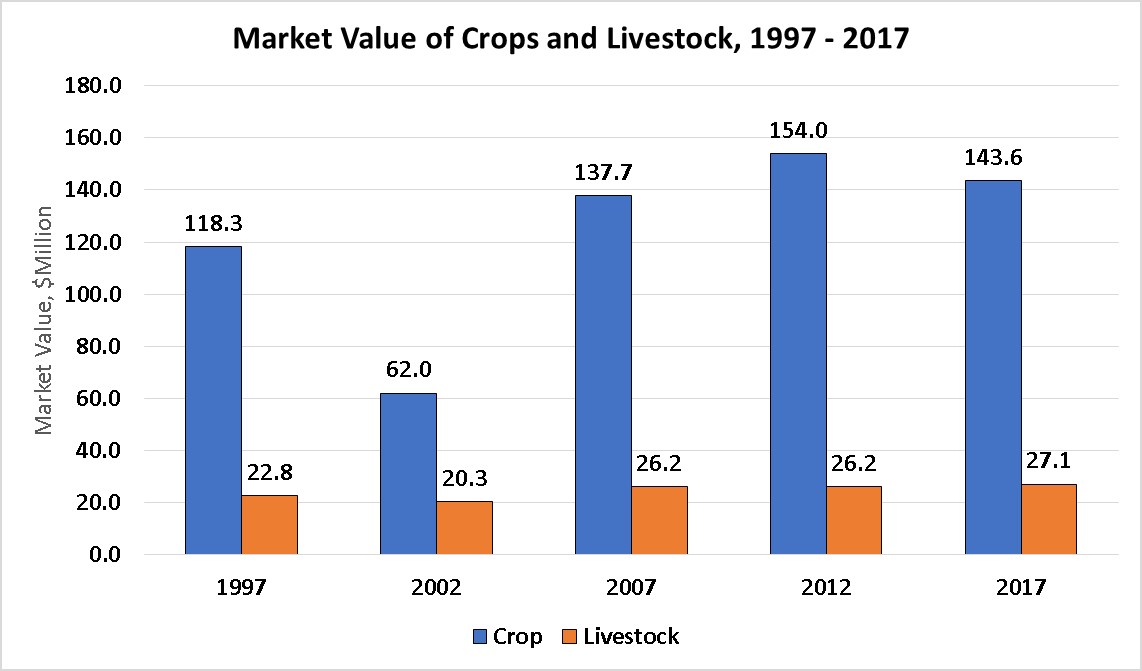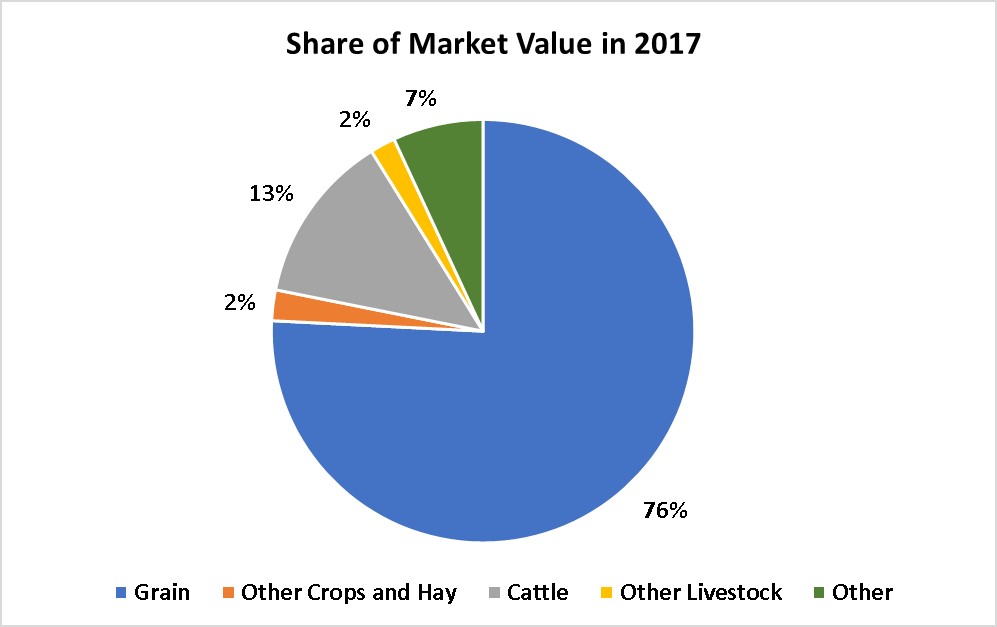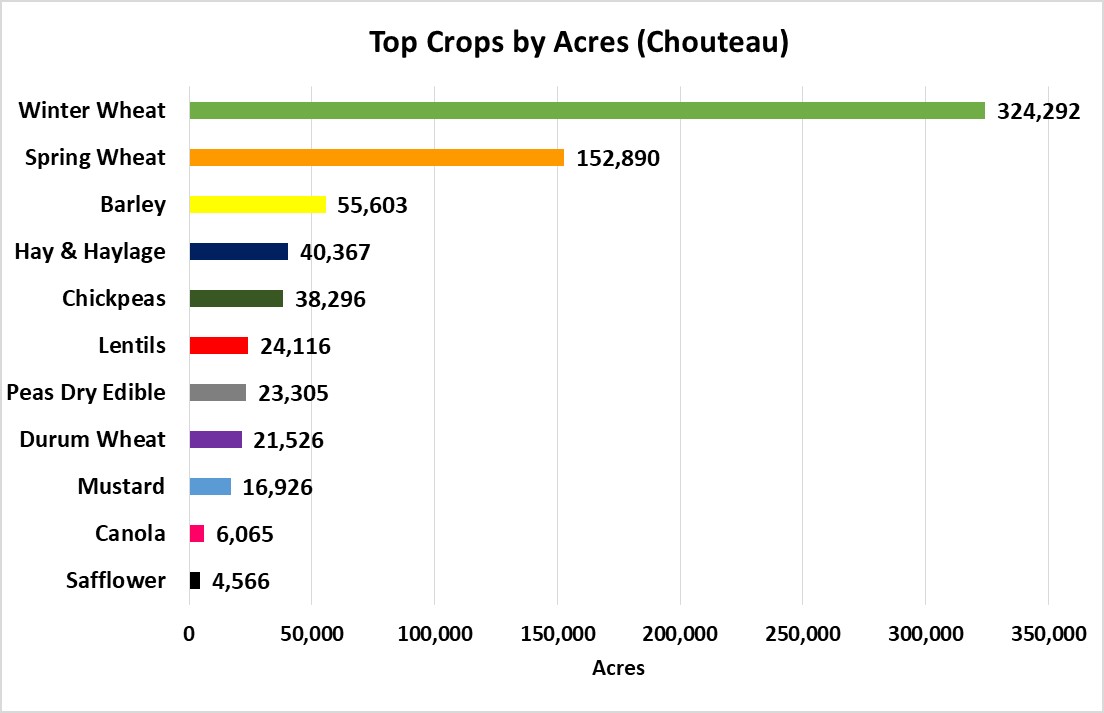Economic Impact of Agriculture
Chouteau County
Chouteau County is a rural county located in North Central Montana, and contains part of the Rocky Boy Reservation. Over 81% of land in Chouteau County is classified as farm land.
Overview
|
|
|
|
|
|
|
|
|
|
|
|
| Median Farm Size (acres) | 1,829 |
| Average Farm Size (acres) | 3,271 |
Source: Census of Agriculture: Table 1: County Summary Highlights: 2017
Farm Revenue
Farm revenue (which includes the market value of products sold, government payments,
and farm-related income) were over $204 million while production expenses were $154
million. Government payments were 11% of farm revenues.
|
|
|
|
|
|
|
|
|
|
|
|
| Net Farm Cash Income | $50,282,000 |
Source: Census of Agriculture: Tables 2, 3, 4, 5 and 6: 2017
Taxation
The market value of all property in Chouteau County was approximately $1 billion in
2019. The taxable value assigned by the Montana Department of Revenue was $9.7 million.
Agricultural Property (as defined by Montana Department of Revenue as Class 3 Property)
comprised 35% of the county's taxable value.
|
|
|
2014 |
| Market Value of Property | $1,082,582,883 | $1,185,252,694 |
| Taxable Value of All Property | $27,848,525 | $20,023,419 |
| Taxable Value ofAgricultural Property | $9,755,612 | $7,492,755 |
| Ag Taxable Value as % of All Property | 35% | 37% |
Source: Montana Dept. of Rev. Montana Taxes by County in2018and Montana Taxes by County in2014
Market Value of Crops and Livestock
After adjusting for inflation, the market value of crops increased by 21%, while the
market value of livestock increased by 19%, from 1997 to 2017.
Sources: Census of Agriculture: Table 1: County Summary Highlights: 2017 and St. Louis Fed Producer Price Index
Crops and Livestock
Grain (76%) and cattle (13%) comprised 89% of total crop and livestock sales in 2017.

Source: Census of Agriculture: Table 2: County Summary Highlights: 2017
Farm Size by Acres
The percentage of smaller farms, less than 500 acres, increased slightly from 24% to 26%, while the percentage of larger farms, 500 acres or more, decreased slightly from 76% to 74% from 2012 to 2017.
|
by Acres |
2017
|
2012
|
||
|
Farms |
% |
Number of
Farms |
% |
|
|
1 to 9
|
2
|
0
|
17
|
2
|
|
10 to 49
|
25
|
4
|
26
|
3
|
|
50 to 179
|
68
|
11
|
67
|
9
|
|
180 to 499
|
70
|
11
|
79
|
10
|
|
500 to 999
|
79
|
12
|
96
|
12
|
|
1,000 or more
|
389
|
61
|
489
|
63
|
|
TOTAL
|
633
|
100
|
774
|
100
|
Farm Size by Sales
The proportion of total sales from the smallest farms with less than $100,000 in sales decreased from 50% to 48%, while the proportion of total sales from the largest farms with sales of $100,000 or more increased from 50% to 52% from 2012 to 2017.
|
by Sales |
2017
|
2012
|
||
|
Farms |
% |
Number of
Farms |
% |
|
|
Less than 2,500
|
156
|
25
|
219
|
28
|
|
2,500 to 4,999
|
3
|
0
|
23
|
3
|
|
5,000 to 9,999
|
11
|
2
|
17
|
2
|
|
10,000 to 24,999
|
38
|
6
|
40
|
5
|
|
25,000 to 49,999
|
42
|
7
|
36
|
5
|
|
50,000 to 99,999
|
52
|
8
|
49
|
6
|
|
100,000 or more
|
331
|
52
|
390
|
50
|
|
TOTAL
|
633
|
100
|
774
|
100
|
Source: Census of Agriculture: Table 1: County Summary Highlights: 2017
Tillage and Land Use
The percentage of farms using no till increased, while the percentage of farms using reduced or intensive tillage decreased from 2012 to 2017.
|
|
2017
|
2012
|
||
|
Farms |
% |
Number of
Farms |
% |
|
|
No tillage
|
358
|
57
|
357
|
46
|
|
Reduced tillage
|
52
|
8
|
78
|
10
|
|
Intensive tillage
|
35
|
6
|
116
|
15
|
|
Cover crops
|
18
|
3
|
24
|
3
|
|
TOTAL
|
633
|
|
774
|
|
Producer Profile
The county producer population was about the same age as the Montana producer population.
Thirty-five percent of county producers were under 55 years of age, while 32% were
over 65 years of age. Thirty-four percent of the Montana producer population were
under 55, while 36% were over 65 years of age. Sixty-four percent of producers in
the county were males, while 60% of Montana producers were males. Farming was the
primary occupation for 66% of county producers, while farming was the primary occupation
for 50% of Montana producers.
|
|
County
|
State
|
||
|
Producers |
% |
Number of
Producers |
% |
|
|
Age
|
||||
|
18 -25
|
12
|
1
|
570
|
1
|
|
25 to 34
|
98
|
8
|
3,285
|
7
|
|
35 to 44
|
156
|
13
|
5,179
|
11
|
|
45 to 54
|
150
|
13
|
7,309
|
15
|
|
55 to 64
|
360
|
30
|
13,838
|
29
|
|
65 to 74
|
227
|
19
|
11,469
|
24
|
|
75 and older
|
154
|
13
|
5,587
|
12
|
|
Gender
|
||||
|
Male
|
761
|
64
|
28,563
|
60
|
|
Female
|
423
|
36
|
18,673
|
40
|
|
Primary Occupation
|
||||
|
Yes
|
782
|
66
|
23,847
|
50
|
|
No
|
402
|
34
|
24,314
|
50
|
|
TOTAL PRODUCERS
|
1,184
|
100
|
48,161
|
100
|
Source: Census of Agriculture: Table 45 Selected Operation and Producer Characteristics
Top Crops by Acre
The top crops were winter and spring wheat, barley, hay and haylage, chickpeas, lentils, peas dry edible, durum wheat, mustard, canola and safflower.

Source: Census of Agriculture: Table 1: County Summary Highlights: 2017
Top Livestock
The top livestock were chickens-layers, cattle and sheep.
|
|
|
|
Chickens-Layers
|
93,291
|
|
Cattle
|
37,644
|
|
Sheep
|
577
|
Source: Census of Agriculture: Tables 11 (Cattle) and 13 (Sheep)
Employment Impact
Agricultural production employed 1,622 workers, or 65% of the county’s labor force.
According to IMPLAN, economic impact model, 1,004 of the workers were directly employed
in production agriculture. An additional 569 workers were employed in businesses
supporting agricultural production, such as feed and fertilizer dealers, and another
49 workers were employed in other related businesses, such as grocery and drugs stores.
For every 10 jobs on farms and ranches, 6 additional jobs are generated in the county.
|
|
|
Impact Multipliers |
| County Labor Force | 2,491 | |
| Direct Impact | 1,004 | |
| Indirect Impact | 569 | 0.57 |
| Induced Impact | 49 | 0.05 |
| Total Impact | 1,622 | 0.62 |
| Agriculture Share (%) | 65 |
Source: Bureau of Labor Statistics, www.bls.gov/#cntyaa and IMPLAN Estimates
Value Added Impacts
Farms and ranches generated $52.5 million of value-added, or 38% of the county’s total
gross domestic product of $137 million in 2017. According to IMPLAN, $23.8 million
was directly contributed by farmers and ranchers. An additional $25.9 million was
generated by businesses supporting agricultural production and $2.8 million was generated
by other related businesses. Each dollar of value-added in agriculture by a farmer
or rancher contributes an additional $1.21 of value-added in other sectors of the
county’s economy.
|
Impact Type |
($1 million) |
Impact Multipliers |
| County GDP* | 137.0 | |
| Direct Impact** | 23.8 | |
| Indirect Impact** | 25.9 | 1.09 |
| Induced Impact** | 2.8 | 0.12 |
| Total Impact** | 52.5 | 1.21 |
| Agriculture Share (%) | 38 |
Sources: * St. Louis Federal Reserve Bank, ** IMPLAN Estimates
References
- 2017 Census of Agriculture, National Agricultural Statistics Service, Montana, State and County Data, Volume 1, Geographic Area Series, part 26 https://www.nass.usda.gov/Publications/AgCensus/2017/Full_Report/Volume_1,_Chapter_1_State_Level/Montana/mtv1.pdf
- Department of Revenue “Montana Taxes by County in 2014“ https://mtrevenue.gov/wp-content/uploads/2018/01/2014-Taxes-by-County.pdf
- Department of Revenue “Montana Taxes by County in 2018” https://mtrevenue.gov/wp-content/uploads/2020/02/2018-Taxes-by-County.pdf
- St. Louis Federal Reserve Bank (2017). Current dollar gross domestic product by county
for Montana, retrieved from https://fred.stlouisfed.org/release/tables?rid=397&
eid=1062609&od=2017-01-01# - St. Louis Federal Reserve Bank (2020). Producer price index for all commodities, St. Louis Federal Reserve Bank, retrieved from https://fred.stlouisfed.org/series/PPIACO
- Bureau of Labor Statistics (2017), Montana labor force, retrieved from https://bls.gov/lau/#cntyaa
Montana State University Extension is an ADA/EO/AA/Veteran’s Preference
Employer and Provider of Educational Outreach.
